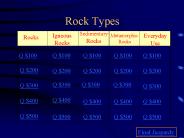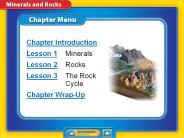Lithification PowerPoint PPT Presentations
All Time
Recommended
Lithification. Weathering & Volcanism. Dissolution. Photosynthesis. Burial & Lithification. Exsolution. Carbon Cycle. Atmosphere. Hydrosphere. Lithosphere. Biosphere ...
| PowerPoint PPT presentation | free to view
Sedimentary Rocks Lithification Sediments Deposition Transport Erosion Weathering Weathering Mechanical Weathering Chemical Weathering Mineral Stability Products of ...
| PowerPoint PPT presentation | free to download
Lithification Time. Physical and Chemical. Weathering. Water. Ice. Waves. Expansion. Contraction ... Lithification. Compaction. Precipitation Time. Chemical ...
| PowerPoint PPT presentation | free to view
Sedimentary Rocks Made from Sediments!! AIM: What are the characteristics of sedimentary rocks? Sedimentary rocks are formed from the accumulation and lithification ...
| PowerPoint PPT presentation | free to view
Formation of Sedimentary Rocks Two processes that cause lithification. Learning Targets Metamorphic Rocks When high temperature and pressure combine they change 2 ...
| PowerPoint PPT presentation | free to download
Why do some rocks have layers? ... the compaction and cementation (lithification) of sediments into visible layers called beds. ...
| PowerPoint PPT presentation | free to download
Minerals crystallize and cement together to form rock ... Compacted and cemented (lithification) Can be large and rounded sediments ...
| PowerPoint PPT presentation | free to view
... suspension or solution Deposition Settling of Grains Diagenesis Post-depositional changes and lithification Sediment Grain Size Sediment Grain Size and Energy ...
| PowerPoint PPT presentation | free to download
Primary vs secondary structures. Primary- formed as consequence of lithification. Secondary- process that occurred after lithification. Types of Stress. Plunging folds ...
| PowerPoint PPT presentation | free to view
Depositional feature of sedimentary rock that forms as ... Examples include breccia, sandstone, and shale; formed by lithification of clastic sediments. ...
| PowerPoint PPT presentation | free to view
An analysis of the mineral will always produce the same ratio of ... Formed from the lithification (compaction and dehydration) of sediments in oceans and lakes ...
| PowerPoint PPT presentation | free to view
Once we weather the source material, the material is ... (a.k.a. clastic) form by compaction and lithification of clastic sediments or lithic fragments ...
| PowerPoint PPT presentation | free to view
Limestone is a sedimentary rock which is composed of calcium carbonate along with calcium or magnesium. It is formed when layers of minerals, fine sediment along with skeleton fragments and shells of marine organisms go through lithification. First of all, the report provides the limestone market overview with the detailed analysis on the market segmentation. The market is segmented by types, applications, manufacturers and regions. By type, the market covers, high calcium limestone and magnesium limestone. For more information visit the below URL http://www.marketresearchhub.com/report/global-limestone-market-research-report-2016-report.html
| PowerPoint PPT presentation | free to view
Form when particles drop from a moving current, such as a flowing river or wind. ... Red = Oxidizing environment. Terrestrial settings. Green = Reducing environment ...
| PowerPoint PPT presentation | free to download
Title: PowerPoint Presentation Author: Valued Gateway Client Last modified by: Dave Hardin Created Date: 6/30/2002 8:20:43 PM Document presentation format
| PowerPoint PPT presentation | free to download
Sedimentary Rock The rocks that form the Earth s surface are broken down and washed away by mechanical and chemical weathering and erosion. But rocks are formed ...
| PowerPoint PPT presentation | free to view
Bedding - layering! Layering of sediments is common due to ... Cross-bedding (inside ... large scale cross-bedding in these sandstones (interpreted ...
| PowerPoint PPT presentation | free to view
TYPES OF ISOTOPIC DATING TECHNIQUES. Uranium (U) - Thorium (Th) - Lead (Pb) Dating ... (K) - Argon (Ar) Dating. Problem with K-Ar dating is that the Argon ...
| PowerPoint PPT presentation | free to download
Sedimentary Rock Classification Rock cycle What are Sedimentary Rocks? What are sediments? How do sediments form sedimentary rocks? Where do sedimentary rocks form?
| PowerPoint PPT presentation | free to download
chapter 6.3 sedimentary rocks chapter 6.3 sedimentary rocks sedimentary rocks 95% of earths crust is igneous rock, and 4-5% is sedimentary and metamorphic rock ...
| PowerPoint PPT presentation | free to view
Igneous rock occurs in many forms: Granite. Andesite. Obsidian. Pumice. Basalt. It all depends on the MINERALS inside the magma! But how does the magma come up at all? ...
| PowerPoint PPT presentation | free to view
The Rock Cycle Janet Hong Jane Kim Jenny Kim Lynn Yi What is a Rock? A rock is a mixture of one or more minerals, glass, and sometimes, organic matter.
| PowerPoint PPT presentation | free to download
An Introduction to Geology Sedimentary Rocks Hand specimens What sedimentary rock type is your specimen? Sedimentary structures Bedding Sedimentary structures Cross ...
| PowerPoint PPT presentation | free to download
Earth Science Daily Challenge, 12/11. What ... processes that make sedimentary rock. weathering breaking up of materials into sediments and dissolved solids ...
| PowerPoint PPT presentation | free to view
Chemical minerals are altered or dissolved ... 4) Conglomerate/Breccia. Increasing Grain Size. Organic Sedimentary Rocks. Coal ...
| PowerPoint PPT presentation | free to view
Explore the key differences between sandstone vs limestone for natural stone flooring and paving. World of Stones offers premium sandstone and limestone in various colors like red, yellow, and green. Discover which stone is best for your project in our detailed blog!
| PowerPoint PPT presentation | free to download
Explore the key differences between sandstone vs limestone for natural stone flooring and paving. World of Stones offers premium sandstone and limestone in various colors like red, yellow, and green. Discover which stone is best for your project in our detailed blog!
| PowerPoint PPT presentation | free to download
Journal Entry Open books to P. 116-117 to analyze picture and answer questions What is distinctive about this rock formation? What does the shape of this rock ...
| PowerPoint PPT presentation | free to download
Sediment and Sedimentary Rocks Big rocks into pebbles, Pebbles into sand. I really hold a million, million Rocks here in my hand. Florence Parry Heide
| PowerPoint PPT presentation | free to view
Focus On Life Science
| PowerPoint PPT presentation | free to download
Rock Cycle Questions for Today: What is the Rock Cycle? What are the different stages of the Rock Cycle? How do the different types of Rock Form and How are they related?
| PowerPoint PPT presentation | free to view
Types of Rocks: Igneous Sedimentary Metamorphic Igneous Rocks Rocks that forms when magma cools and hardens. Form by solidification (crystallization) of melted minerals.
| PowerPoint PPT presentation | free to download
Sedimentary Rocks
| PowerPoint PPT presentation | free to view
Classification of Rocks How do the crystals or minerals form in a rock? Why do some rocks have layers? Why do some rocks have rounded particles while others have ...
| PowerPoint PPT presentation | free to view
Title: Volcanoes and Igneous Activity Earth - Chapter 4 Author: Stan & Cindy Hatfield Last modified by: BASD Created Date: 12/18/2000 12:31:17 AM
| PowerPoint PPT presentation | free to download
Sedimentary Rock Distinct layering Beds Bed 1 Bed 2 ... much research as part of the Snowball Earth ... of organisms Foraminifera ...
| PowerPoint PPT presentation | free to view
Rock Types Sedimentary Rocks Igneous Rocks Everyday Use Metamorphic Rocks Rocks Q $100 Q $100 Q $100 Q $100 Q $100 Q $200 Q $200 Q $200 Q $200 Q $200 Q $300 Q $300
| PowerPoint PPT presentation | free to download
Rock Types Sedimentary Rocks Igneous Rocks Everyday Use Metamorphic Rocks Rocks Q $100 Q $100 Q $100 Q $100 Q $100 Q $200 Q $200 Q $200 Q $200 Q $200 Q $300 Q $300
| PowerPoint PPT presentation | free to download
No major glaciations accompanied the Permian, Triassic and Cretaceous ME s. Another major glaciation, ca. 300 million years ago, and lasting 90 million yrs, ...
| PowerPoint PPT presentation | free to view
Title: Geol 102 Earth Materials Author: x Created Date: 12/14/2003 3:56:00 PM Document presentation format: On-screen Show Company: University of Delaware
| PowerPoint PPT presentation | free to download
Sediments and Diagenesis The Rock Cycle is a group of changes. It is an ongoing process. Igneous rock can change into sedimentary rock or into metamorphic rock.
| PowerPoint PPT presentation | free to view
A fresh impact crater, which punches through the etched layers, aids in ... Looks like a crater. Craters are common! Explains blanket around circular feature ...
| PowerPoint PPT presentation | free to view
The Rock Cycle The Rock Cycle Through many different geologic processes, the rocks that make up the earth s crust form, change, get destroyed, and re-form over and ...
| PowerPoint PPT presentation | free to download
... layers of chemical sedimentary rocks that form as a result of this process are called evaporites The three most common evaporites are calcite, halite, ...
| PowerPoint PPT presentation | free to view
Commonly deposited in deep oceans (not abyssal plain) OR shallow seas with ... Nichols, G., 2002, Sedimentology and Stratigraphy, 144 pp. Blackwell Science Ltd, ...
| PowerPoint PPT presentation | free to view
ROCKS Rocks naturally formed, non-living masses of solid Earth material that are made up of minerals. There are three types of rocks: 1) Sedimentary sediments
| PowerPoint PPT presentation | free to view
Rock Types Sedimentary Rocks Igneous Rocks Everyday Use Metamorphic Rocks Rocks Q $100 Q $100 Q $100 Q $100 Q $100 Q $200 Q $200 Q $200 Q $200 Q $200 Q $300 Q $300
| PowerPoint PPT presentation | free to view
Igneous, Sedimentary, and Metamorphic Rocks Solidified products of once-molten material called magma Interlocking arrangement of mineral crystals that forms as the ...
| PowerPoint PPT presentation | free to view
Sedimentary Rock c. Classify rocks by their process of formation. d. Describe processes that change rocks and the surface of the earth.
| PowerPoint PPT presentation | free to download
Clastic sediments are rock and mineral fragments produced by weathering and erosion. ... Clastic. Formed from clastic sediments. Characterized by particle size ...
| PowerPoint PPT presentation | free to view
Geology 3120 Sedimentary Structures
| PowerPoint PPT presentation | free to view
Feldspars fall into this category and make up at least 40% of all the igneous rocks. ... The two magma bodies may have very different chemical compositions. ...
| PowerPoint PPT presentation | free to view
Title: Chapter 4 - Rocks Author: A C REYNOLDS HIGH SCHOOL Last modified by: lil Drama Created Date: 7/12/2005 6:43:59 PM Document presentation format
| PowerPoint PPT presentation | free to view
Title: Slide 1 Author: Lawrence McGlinn Last modified by: Georgina DeWeese Created Date: 12/28/2006 2:09:16 AM Document presentation format: On-screen Show (4:3)
| PowerPoint PPT presentation | free to download
The textures of most metamorphic rocks ... Minerals luster cleavage fracture ore Lesson 1-1 A ... cleavage What are deposits of minerals that can ...
| PowerPoint PPT presentation | free to download
























































